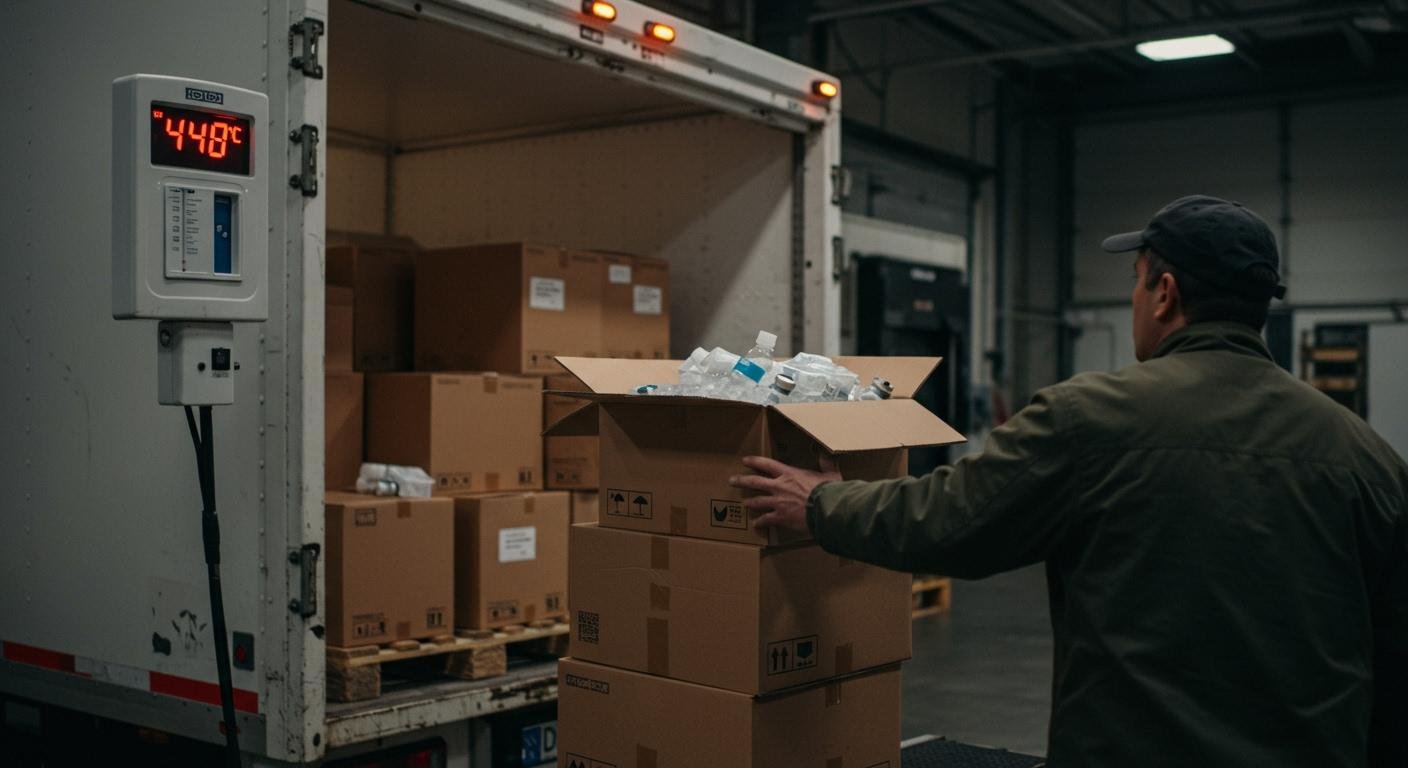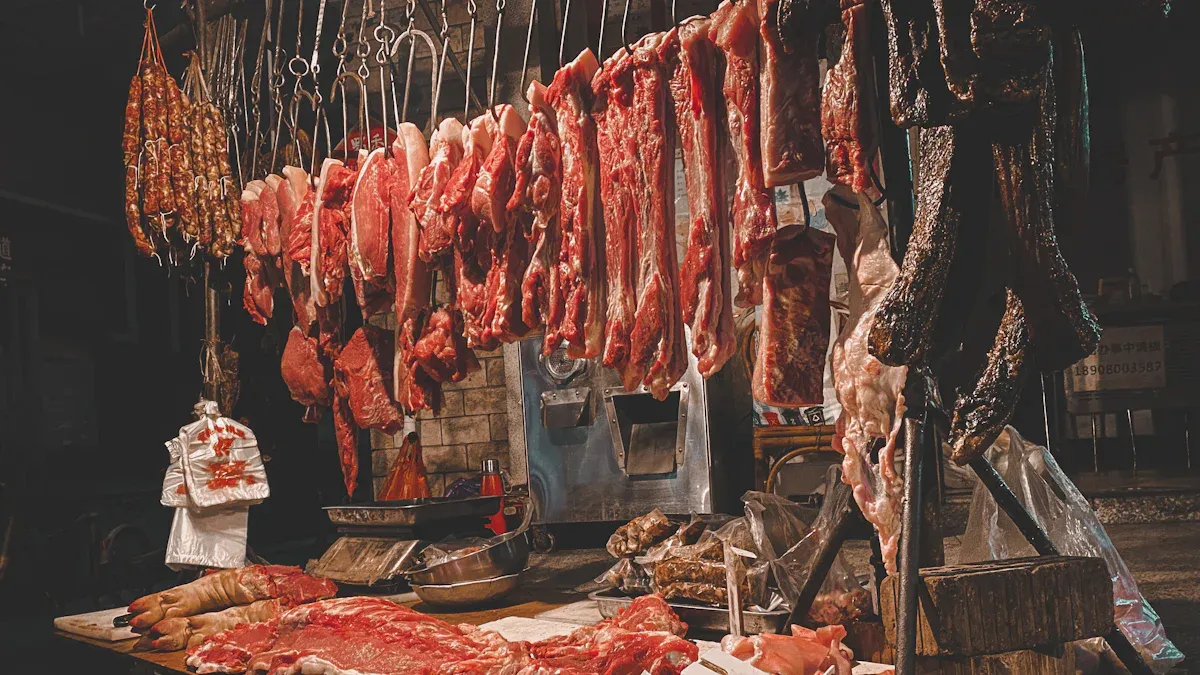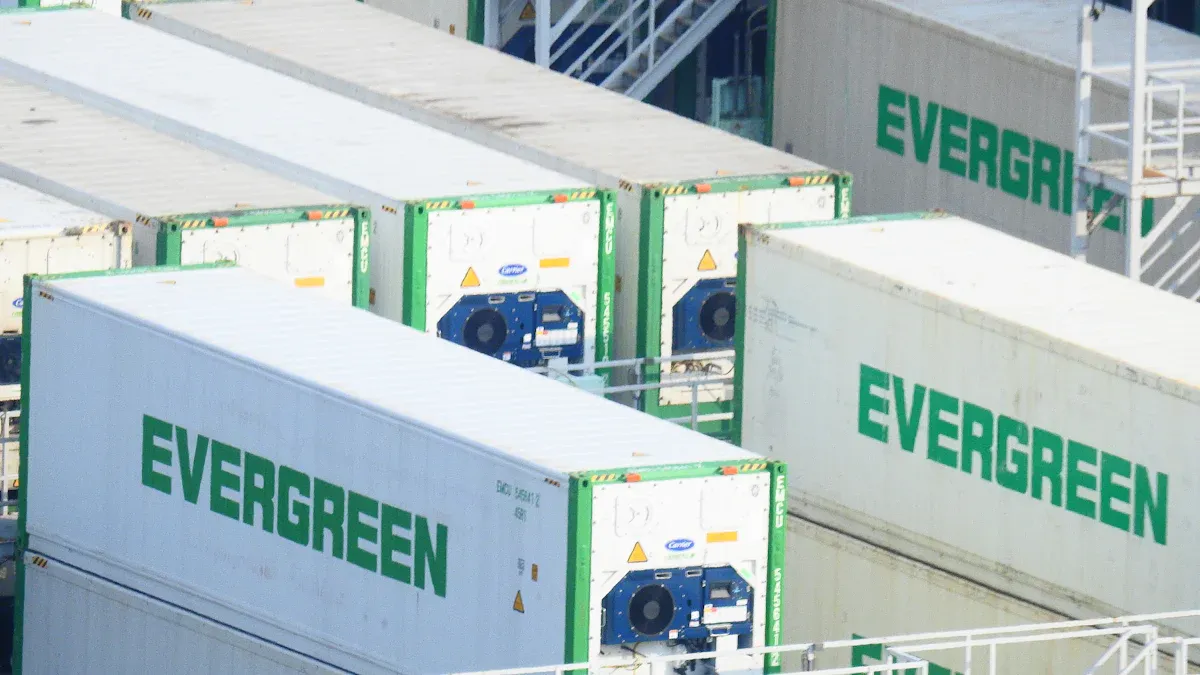What Is Cold-Chain Logistics? A Simple Guide
Table of Contents

Cold-chain logistics is a temperature-controlled supply chain. Think of it as a large “refrigerator on the move.” This system protects temperature-sensitive products. It maintains their quality and safety from the factory to your home. The cold chain supply is a massive, growing industry, as shown by its market size.
| Year | Market Size (USD Billion) |
|---|---|
| 2024 | 316.34 |
| 2025 | 371.08 |
PRESERVING PRODUCT INTEGRITY AND SAFETY
The primary goal of the cold chain is to preserve product integrity and safety. For perishable goods like food, effective temperature control prevents spoilage. It stops harmful bacteria from growing and maintains the food’s quality, texture, and nutritional value. This process keeps food safe to eat. The global cold chain supply is essential, as inadequate infrastructure causes the loss of 13% of all food produced each year. Proper management ensures that fresh produce, dairy, and meat arrive at stores with the same quality as when they left the farm.
The system is also vital for public health. Many pharmaceuticals are temperature-sensitive products that lose effectiveness if not kept within a specific temperature range. Effective cold-chain logistics protects these life-saving medicines. Failures can be costly. The biopharma industry loses an estimated $35 billion annually from failures in temperature-controlled shipping. These losses highlight the financial importance of an unbroken cold chain.
More importantly, failures in cold chain management have serious health consequences. A compromised vaccine or medicine can become ineffective or even harmful.
Real-world incidents show the risks of a broken cold chain:
- A freezer malfunction in California put over 800 Moderna vaccines at risk, requiring an emergency distribution effort.
- Improper storage spoiled approximately 1,000 vaccine doses at a hospital in India.
- In parts of Africa, unreliable power and a lack of ultra-cold freezers have jeopardized vaccination programs for diseases like COVID-19.
These examples demonstrate why precise cold chain management is not just a logistical challenge but a critical component of global public health.
PRODUCTS REQUIRING COLD-CHAIN LOGISTICS

A wide variety of goods depend on an unbroken temperature-controlled journey. While food and medicine are the most common, many other products also require careful handling. Effective cold chain management ensures these items reach consumers and patients safely and in optimal condition.
FOOD AND BEVERAGES
The food and beverage industry is a primary user of the cold chain supply. The processed food segment holds the largest market share. This dominance comes from the need to preserve quality from raw material sourcing to final distribution. Consumers’ growing demand for processed and fresh foods increases the need for a strong cold chain infrastructure.
Different foods have unique temperature needs. A failure to maintain these specific ranges can lead to spoilage, loss of texture, and reduced nutritional value. Fruits and vegetables are very sensitive. They can lose crispness and become mushy if not kept cool. Proper temperatures are essential for maintaining their quality.
Did You Know? 💡 Specific temperature ranges are critical for different food types. For example, fresh seafood must be kept just above freezing, while frozen vegetables require much colder temperatures to prevent thawing and bacterial growth.
The table below shows the ideal temperature ranges for various food products.
| Product Category | Specific Item | Temperature Range (°C) | Temperature Range (°F) |
|---|---|---|---|
| Fresh Produce | Broccoli | 2°C | 35.6°F |
| Fresh Produce | Citrus Fruits | 8°C – 10°C | 46.4°F – 50°F |
| Dairy Products | Butter & Cheese | 0°C – 7°C | 32°F – 44.6°F |
| Fresh Seafood | Chilled Fish | 1°C – 2°C | 33.8°F – 35.6°F |
| Frozen Foods | Vegetables & Meats | -20°C – -12°C | -4°F – 10.4°F |
PHARMACEUTICALS AND MEDICAL SUPPLIES
The healthcare sector relies heavily on precise cold chain management. The healthcare cold chain logistics market is a significant and growing part of the pharmaceutical industry. Projections show its value reaching over $66 billion by 2030. This growth highlights its importance in modern medicine.
Many medical products are biologics. These are complex molecules derived from living organisms. Most biologics, like the arthritis treatment Humira, must be stored between 2°C and 8°C (36°F and 46°F). Freezing can destroy their molecular structure, making them useless.
Some advanced medicines require even stricter conditions.
- The Ebola vaccine Ervebo needs an ultra-cold environment of -80°C to -60°C.
- Certain COVID-19 vaccines required storage at -70°C.
These extreme requirements demand specialized equipment and protocols. The following table outlines the common storage conditions in pharmaceutical logistics.
| Storage Type | Temperature Range | Common Products |
|---|---|---|
| Refrigerated | 2°C to 8°C (36°F to 46°F) | Most vaccines, insulin, biologics |
| Frozen | -25°C to -15°C (-13°F to 5°F) | Certain vaccines, lab samples |
| Ultra-Low | -70°C to -80°C (-94°F to -112°F) | mRNA vaccines, cell & gene therapies |
Beyond medicines, many other medical and scientific materials need temperature control.
- Biological specimens for research
- Diagnostic and serology kits
- Cell and gene therapies
- High-value lab reagents
- Organs and tissues for transplantation
Even some high-tech electronics and industrial chemicals are sensitive to temperature changes and rely on controlled shipping to maintain stability and function.
ESSENTIALS OF COLD CHAIN MANAGEMENT

Effective cold chain management is not a single action but a system of interconnected components. These elements work together seamlessly to maintain a constant temperature from start to finish. The four pillars of this system are temperature-controlled storage, specialized packaging, refrigerated transportation, and continuous monitoring. A failure in any one of these areas can compromise the entire cold chain supply.
TEMPERATURE-CONTROLLED STORAGE
The journey for most temperature-sensitive products begins and ends in a specialized warehouse. These facilities are the fixed points in the cold chain, providing a stable environment for goods. There are several types of cold storage facilities, each designed for specific product needs.
| Storage Type | Temperature Range | Common Products |
|---|---|---|
| Chilled Storage | 0°C to 10°C (32°F to 50°F) | Fresh produce, dairy, some pharmaceuticals |
| Frozen Storage | -25°C to -18°C (-13°F to 0°F) | Frozen meats, ice cream, certain vaccines |
| Ultra-Low Storage | Below -70°C (-94°F) | mRNA vaccines, cell and gene therapies |
These facilities face a significant operational challenge: high energy consumption. Refrigeration systems account for a large portion of the energy used in the food industry. To combat this, modern cold storage warehouses are adopting energy-efficient technologies.
- Next-generation insulation like vacuum insulated panels (VIPs) provides superior thermal resistance.
- Smart temperature control systems use IoT sensors to adjust cooling based on real-time conditions.
- Integrated solar refrigeration offers a renewable energy source to power equipment.
Automation also plays a vital role. Automated Storage and Retrieval Systems (AS/RS) are transforming cold storage operations. These robotic systems increase storage density, improve inventory accuracy, and enhance worker safety by handling tasks in harsh, cold environments. This allows companies to streamline material handling and reduce operating costs.
SPECIALIZED PACKAGING
Packaging is the first line of defense for a product moving through the cold chain. It acts as a mobile micro-environment, protecting goods from temperature fluctuations when they are outside of a cold storage facility or refrigerated vehicle. The goal of proper packaging techniques is to create a thermal barrier that slows the transfer of heat.
Smart Packaging Innovations 💡 Modern packaging goes beyond simple insulation. “Intelligent” packaging uses technology to provide real-time information about a product’s condition.
- Time-Temperature Indicators (TTIs) are labels that change color if a package is exposed to temperatures outside its required range.
- Nanosensors embedded in packaging can detect contaminants like bacteria or moisture.
- Phase Change Materials (PCMs) are substances that absorb and release thermal energy to maintain a specific temperature for an extended period.
Common packaging solutions include insulated box liners, foam bricks, and advanced gel packs. For example, some PCMs are specifically designed to keep products between 2°C and 8°C, a critical range for many biologics. Sustainable options are also becoming more common, with companies using biodegradable materials made from corn starch or recycled cotton to create an effective and eco-friendly cold chain solution.
REFRIGERATED TRANSPORTATION
Refrigerated transportation keeps products cool while on the move. This is arguably the most complex part of cold-chain logistics, as it involves multiple handoffs and potential delays. The primary modes of refrigerated transport are:
- Reefer Trucks: These are specialized trucks with built-in cooling systems. They are ideal for short-to-medium distance deliveries of goods like dairy and fresh produce.
- Reefer Containers: These are large, insulated containers with their own refrigeration units. They are highly versatile and can travel by ship, rail, or truck for long-haul journeys. The global fleet of these containers is over 3.8 million TEU (twenty-foot equivalent units).
- Air Cargo: This is the fastest option for high-value, highly perishable items like vaccines or fresh seafood. It uses specialized refrigerated containers designed for aircraft.
A major challenge in this area is environmental impact. The Transportation Refrigeration Units (TRUs) that power these systems are energy-intensive and often rely on fossil fuels. A van with a TRU can produce approximately 15% more CO2 emissions than a standard vehicle. The industry is actively exploring a transition to eco-friendly refrigerants like ammonia and CO2 to reduce its carbon footprint.
CONTINUOUS MONITORING
You cannot manage what you cannot measure. Continuous monitoring is the process of tracking a product’s environment throughout its entire journey. This is essential for ensuring compliance, identifying weak points in the cold chain shipping process, and proving that product integrity was maintained. Effective cold chain management depends on reliable data.
Modern cold chain shipping uses advanced technology for this purpose.
- IoT Sensors and Data Loggers: These small devices are placed with the cargo to record temperature, humidity, and location in real time.
- Software Platforms: Data from sensors is transmitted to a central dashboard. This software provides end-to-end visibility, sends automated alerts if temperatures deviate, and creates a digital audit trail for regulatory compliance.
This technology allows logistics providers to be proactive. Instead of discovering a problem after a shipment arrives, real-time alerts enable them to intervene when a deviation occurs. For pharmaceuticals, this level of oversight is not just good practice—it is a regulatory requirement.
Good Distribution Practices (GDP) GDP guidelines, established by agencies like the European Medicines Agency (EMA), mandate that pharmaceutical distributors use continuous monitoring systems. This ensures that medicines are protected from conditions that could alter their quality and effectiveness. Companies use data from sensors to run simulations of real-world shipping environments, validating that their processes meet these strict standards.
Effective cold-chain logistics is an essential, interconnected system. It is not just a single process. This network ensures the safety of the food on our plates and the effectiveness of the medicines we depend on. The success of cold chain shipping protects public health and supports daily life.
This complex logistical web works silently in the background. It is a vital, unseen pillar of the modern world, guaranteeing product quality from origin to consumer.
FAQ
What happens if the cold chain breaks?
A broken cold chain spoils food and ruins medicines. Spoiled goods can become unsafe or ineffective. This failure threatens public health and creates large financial losses for companies. A single temperature deviation can compromise an entire shipment.
Is cold-chain logistics expensive?
Yes, cold-chain logistics is expensive. It requires specialized equipment, constant energy for refrigeration, and advanced monitoring technology.
Note: Companies make these investments to protect product value and ensure consumer safety, as the cost of failure is often much higher.
How does technology improve the cold chain?
Modern technology is vital for cold chain management. IoT sensors provide real-time temperature and location data. Automated systems in warehouses boost efficiency and safety. This tech ensures constant control and visibility over shipments from start to finish.
What is the difference between chilled and frozen storage?
Chilled storage keeps products cool, typically between 0°C and 10°C (32°F and 50°F). Frozen storage keeps items solid, usually below -18°C (0°F). Each method preserves different goods, such as fresh produce (chilled) or ice cream (frozen).

Poseidon
Master of Nutritional Epidemiology, University of Copenhagen, Herbal Functional Nutrition Researcher
Focus: The scientific application of natural active ingredients such as Tongo Ali, Horny Goat Weed, and Maca to sexual health and metabolic regulation.
Core Focus:
Men: Use a combination of Tongo Ali (an energizing factor) + Maca (an energy reserve) to improve low energy and fluctuating libido.
Women: Use a combination of Horny Goat Weed (a gentle regulator) + Maca (a nutritional synergist) to alleviate low libido and hormonal imbalances.
Stressed/Middle-Aged Adults: This triple-ingredient synergy supports metabolism, physical strength, and intimacy.
Product Concept:
Based on traditional applications and modern research (e.g., Tongo Ali promotes testosterone-enhancing enzyme activity, and icariin provides gentle regulation), we preserve core active ingredients and eschew conceptual packaging—using natural ingredients to address specific needs.
Simply put: I'm a nutritionist who understands "herbal actives." I use scientifically proven ingredients like Tongo Ali, Epimedium, and Maca to help you make "sexual health" and "nutritional support" a daily routine.
